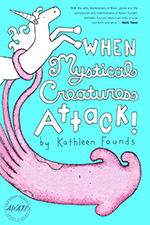When Mystical Creatures Attack! by Kathleen Founds
 When Mystical Creatures Attack!
When Mystical Creatures Attack!
Kathleen Founds
University of Iowa Press, 2014
206 pages
ISBN 978-1609382834, $12.97
In this genre-blending novel-in-stories, Kathleen Founds experiments with different narrative modes to show how characters connect with and understand each other. When Mystical Creatures Attack! pushes the boundaries of flash fiction as it demonstrates how much of our daily communication takes the form of micro-writing such as emails and lists. While the collection does contain some longer stories, most of the episodes or chapters are fragmented and portray multiple viewpoints through the use of first- and second-person narration and epistolary exchanges. The opening story (that also provides the title for the collection) introduces Laura Freedman’s south Texas high school English class through a journaling exercise: “Write a one-page story in which your favorite mystical creature resolves the greatest sociopolitical problem of our time.” The students’ responses range from a couple of sentences to two or three paragraphs, but are arranged so that a reader gets a full sense of their interior lives. Like a creative writing Rorschach test, the students’ responses reveal their personal struggles with poverty, teenage pregnancy, and youthful optimism in the face of overwhelming odds.
Janice Aurelia Gibbs emerges as one of the main characters. As the editor of the school literary magazine, El Giraffe, Janice feels an instant affinity for Miss Freedman, especially since her mother left her and her father moved to another state to work. As Janice’s life goes into a downward spiral, she endures an unwanted pregnancy, becomes alienated from the rest of her family, is arrested for stealing. Although Janice’s straightforwardness leads the reader to assume that she is an objective observer of her own life, the shifting viewpoints suggest that each character is aware that they can manipulate their stories to reach whatever conclusion they desire. Janice’s elegant use of language contrasts with her impoverished surroundings, as in the story, “Their Trunks Were Their Handles”: “Sitting on the cold cement, Janice felt foreign to herself. A thousand years away from any city she had known. Maybe by city she meant her childhood.” With understated sadness, Janice transposes time and place as she imagines her life as a metaphorical location. Yet her eloquence does not line up with her self-identification as a “feral raccoon,” a phrase lifted from Laura’s journal about her students: “Janice Gibbs: a feral child with excessive eye shadow and stringy black hair that obscures her face. I feel a daily urge to take scissors to it. She has an antiauthoritarian complex that would be interesting were it not so ill informed.” Janice rebels against her mentor’s racial and cultural prejudice even as she sardonically claims it as her own.
Janice’s eventual redemption narrative is partly due to Founds’s sensitivity to the generational poverty that many of her characters face. Janice’s awareness of class differences leads her to rebel in particular ways. Woven into the realistic fabric are frequent references to Christianity as a common element in the characters’ lives. Founds includes moments of Catholicism and Protestantism, but not in a way that situates one as holding more hope than another. Instead, religion provides a way for her characters to look outside themselves as they try to find a divine meaning to their lives. In “Recipes for Disaster,” dark secrets are hidden in Methodist church cookbook; one is “Drinking Alone Cherry Soda”: “Put your husband down for a nap, turn on the television, and tell the hospice worker you’re drinking strawberry Metamucil. This county may be dry, but everyone needs a little comfort, whether it comes from the souls of other humans or bourbon.” Janice discusses her disdain for her stepmother’s religious fervor that borders on hypocrisy, but later finds comfort in the routine it provides in her life.
Laura Freedman provides somewhat of a foil to Janice’s cynical optimism. Although she is born into privilege that her students will never know, Laura suffers from a mental illness that claimed her mother when she was four. After her mother’s suicide, her father devoted himself to his business at the expense of his soul. In one journaling exercise, Laura unsympathetically describes her father’s love of capitalism, then adds: “Please note: I’m not trying to get my father to choke down a communion wafer before he dies. That’s not important. What I want for him is to experience some kind of opening outward.” Laura enters a Teach for America-like program but quickly loses her idealism when she sees how desperate her students are and how ill equipped she feels to solve their problems. Given Janice’s devotion to her in spite of her detachment, the tragedy of Laura’s narrative is that she wants to find someone or something to blame for her unhappiness, even if there is nothing that deserves blame. Other characters round out the collection, such as Janice’s friend Cody, who imposes artificially imposed plot structures to his adventures using hard-boiled detective or horror tropes. The frequent shifts in tone create a surrealist atmosphere, but Founds balances Cody’s amateurish writing with Janice’s sarcasm and the desperate symbolism of Laura’s journal to sublime effect. Although the moments of redemption are less Biblical in scale than the characters would want, Founds shows that sensitivity and compassion help us survive Earth’s diurnal course.
